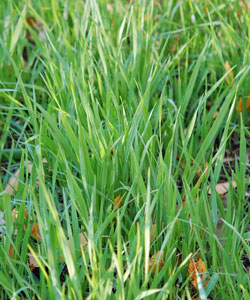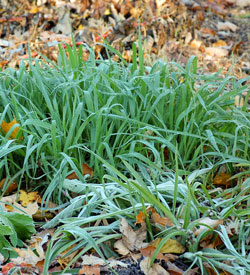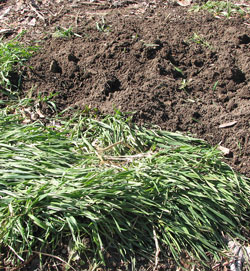Using cover crops
 ©Janet AllenOne of our cover crops
©Janet AllenOne of our cover cropsAnother way we protect and enrich the soil is to plant cover crops when the soil would otherwise be bare (a common situation here in CNY with our short growing season). The cover crops not only protect the soil, but when they're dug in, they become "green manure," helping to further enrich the soil.
Cover crops are important because they prevent weeds from growing, they protect the soil during the winter, and they add nutrients to the soil when they're turned under in the spring. They even help prevent global warming since they sequester carbon.
Clover
 ©Janet Allen Clover
©Janet Allen Clover Clover is a popular cover crop since its nitrogen-fixing root nodules adds this valuable ingredient to the soil.
Clover will not survive the winter but it does provide a thin coat of material covering the soil. It is very easy to turn over in the spring.
I have also sown clover among kale plants during the growing season to suppress weeds and add nitrogen to the soil.
Winter rye
 ©Janet Allen Winter rye beginning to grow
©Janet Allen Winter rye beginning to growSome years I have found my rye seeds don't germinate well. It may be because something eats the seeds or because I have used old seed. Or perhaps I planted it too late, although winter rye is supposed to be one cover crop that can be planted until late October.
It's also possible that I've planted annual rye some years, not winter rye. Annual rye does not survive the winter and won't grow sufficiently if planted late.
 ©Janet Allen Winter rye in November
©Janet Allen Winter rye in NovemberThe winter rye has grown well and will remain here all winter.
 ©Janet Allen Turning under the cover crop in the spring
©Janet Allen Turning under the cover crop in the springWhen spring comes, all that biomass is turned under. It soon decomposes, creating even richer soil.
It is recommended that you wait one month after turning over the rye grass so that it breaks down.
Other cover crops
Oats is another cover crop that grows in the fall and then dies over the winter.
